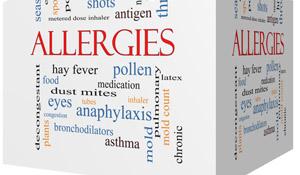
Anaphylaxis is a sudden and serious allergic reaction that can present with a variety of symptoms. In the most severe cases, a patient’s blood pressure falls, airways constrict, and there is difficulty breathing. Common sources of this allergic reaction include certain foods (especially peanuts, tree nuts, and shellfish), medications, insect bites, rubber latex, alcohol (ethanol), and food additives. Emotional stress, heat, cold, sunlight, and even exercise can also trigger an anaphylactic attack. Without treatment, anaphylaxis can quickly become deadly.
If you have known allergies, asthma, another respiratory condition, or heart disease, you are at increased risk for anaphylaxis. Recent studies have also indicated that vitamin D deficiency may be associated with the development of allergies and asthma, thereby increasing the risk of anaphylaxis.
Symptoms
Most anaphylactic reactions will occur within 5 to 30 minutes of exposure to an allergen, but there can be a delay or recurrence within 12 hours. Symptoms may include:
It’s hard to find accurate statistics on the number of people who have experienced anaphylaxis, because the condition has long been underdiagnosed, and therefore underreported (and undertreated); however, a recent study in the Journal of Allergy and Clinical Immunology determined that there were close to 2,500 anaphylaxis-related deaths in the US between 1999-2010.
Many patients presenting with symptoms of anaphylaxis have been diagnosed with less severe allergic reactions, with insufficient treatment and lack of follow-up.
Treatment
Anaphylaxis should be treated as an emergency; if you are experiencing symptoms, you must get immediate medical care.
Anaphylaxis is usually treated with epinephrine (aka adrenaline, a hormone) to help relax the muscles in the airways and tighten the blood vessels, according to MedlinePlus. As New York allergist Jennifer Collins, MD, says, "Use of epinephrine early in a known exposure to an offending agent can be lifesaving."
Epinephrine is given via a prefilled autoinjector administered under the skin or into the muscle on the outside of the thigh. Epinephrine injections should be taken exactly as prescribed by your doctor. Once epinephrine has been administered, "Then take antihistamines and be seen by an emergency room physician as soon as possible," Collins says.
At the ER, you will get further treatment to open your airways, bring up your blood pressure, and maintain heart function until the reaction subsides. After any visit to the emergency room, follow up with an allergist.
Preventing Future Attacks
Anaphylaxis should not be treated as a one-time event but as something that can recur.
To prevent future episodes, "Take allergic reactions seriously, and see an allergist for testing to determine the cause of your allergic reaction," recommends Collins. An allergist will also help you identify where you are most likely to come into contact with allergens, and "Once you’ve identified what triggered your initial event, you, your family, and loved ones should work with the allergist to develop a plan for avoidance and early treatment," Collins explains.
If you’re at risk for an anaphylactic episode, your doctor will provide you with a prescription for at least two epinephrine autoinjectors. "There are several types of injectors in the marketplace, so be sure you and your family have adequate training on the device you have at home," Collins adds. In addition to making sure you, your family members and loved ones know how to administer epinephrine, you should carry an autoinjector with you at all times. Keeping antihistimines on hand and carrying or wearing medical identification is also a good rule of thumb.
Jennifer Collins, MD, reviewed this article.
Sources
Collins, Jennifer MD. Phone and email message to author. September 29, 2014.
Berraies A, Hamzaoui K and Hamzaoui A. "Link Between Vitamin D and Airway Remodeling." Journal of Asthma and Allergy 7 (2014):23-30. Doi: 10.2147/JAA.S46944
Jarvinen KM, Celestin J. "Anaphylaxis Avoidance and Management: Educating Patients and Their Caregivers." Journal of Asthma and Allergy 7 (2014):95-104. Doi: 10.2147/JAA.S48611
Sclar DA, BPharm, Lieberman PL. "Anaphylaxis: Underdiagnosed, Underreported, and Undertreated." The American Journal of Medicine 127, no. 1 (2014): S1-S5. doi: http://dx.doi.org/10.1016/j.amjmed.2013.09.007
"Epinephrine Injection." MedlinePlus. Page last revised December 15, 2012.
"Anaphylaxis: Tips to Remember." American Academy of Allergy Asthma & Immunology. Page accessed October 2, 2014.
Jerschow E, Lin RY, Scaperotti MM, McGinn AP. "Fatal Anaphylaxis in the United States, 1999-2010: Temporal Patterns and Demographic Associations." J Allergy Clin Immunol. 2014 Sep 26. pii: S0091-6749(14)01190-7. doi: 10.1016/j.jaci.2014.08.018. [Epub ahead of print]





